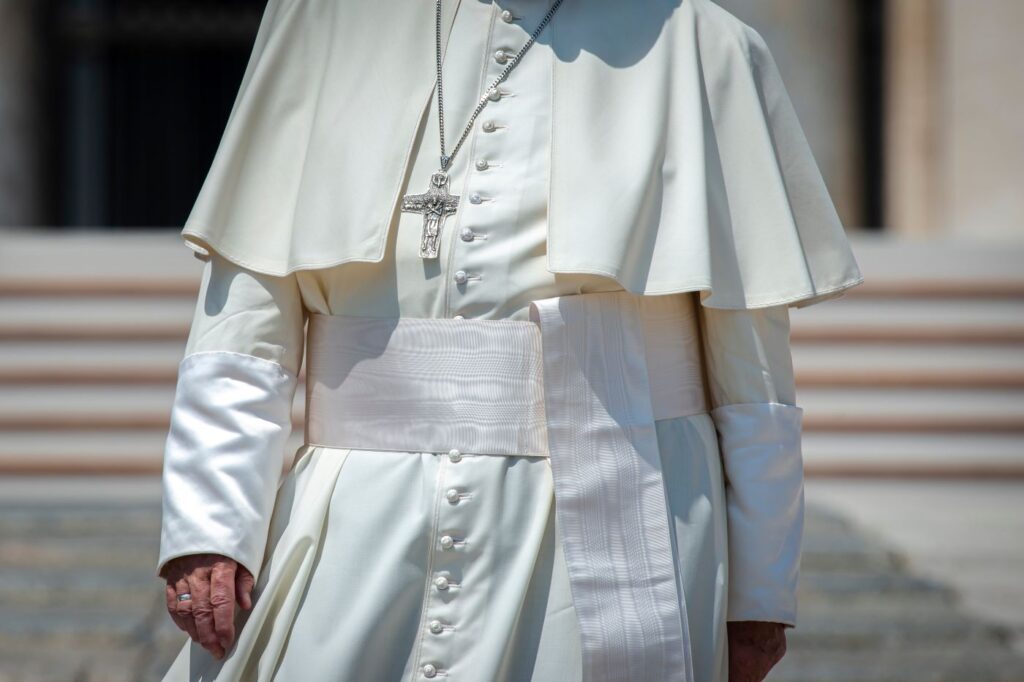One of the unwelcome gifts of the “modern project” is our shrinking attention spans. So I’ll start where I plan to end: Mary Ann Glendon has written one of the best books I’ve read in the last five years. There’s nothing quite like it. And for good reason: a distinguished scholar and Harvard professor emerita of law, Glendon is a veteran consultant to the Vatican in multiple sensitive roles and a former U.S. ambassador to the Holy See. The result, In the Courts of Three Popes, is a vivid, faithful, blessedly frank, and completely absorbing insider’s memoir of her years of service to the Holy See in three very different pontificates.
In discharging that service, Glendon lived and worked as “a stranger in a rather strange land—a layperson in a culture dominated by clergy, an American woman in an environment that was largely male and Italian, and a citizen of a constitutional republic in one of the world’s last absolute monarchies.” The work, as the reader learns, was rewarding, exasperating, and, at times, ironically funny. Vatican protocol could be complex. There was, for example, the moment “when I was introduced to the elderly French Cardinal Paul Poupard and extended my hand” in friendship, rather than kissing his ring, . . . with the effect that “he looked as if he had bitten into a bad escargot.”
More on such things in a moment. But first, some needed context for the Church and the “gifts” of our peculiarly modern moment.
In his great study of the modern project, The Kingdom of Man, the French Catholic philosopher Rémi Brague outlined the roots and course of the Enlightenment and its failure. By seeking to dethrone God and exalt man, the modern project deprives the human experience of any higher meaning or purpose. This leads, inevitably, to self-destructive ends. In seeing man as a god and nature as mere raw material to be manipulated, the pattern is set to use other men—man himself—as raw material to be dominated and remade. Technology now makes this possible in ways unimaginable in the past. This is sobering news, because, in Brague’s words, “the Enlightenment passes for having been humanistic. [But in] fact, the authors who represent it often express a disdain that borders on misanthropy toward man.” In practice, an “emphasis on the dignity of man is only one of the themes of modern thought.” Another, and less noble, is “a certain delight in [man’s] humiliation.”
Start your day with Public Discourse
Sign up and get our daily essays sent straight to your inbox.How does any of this relate to Glendon’s book and its importance? Just in this way: by replacing the sovereignty of God with the sovereignty of man, today’s secularism dispenses with the supernatural, but then needs a stand-in for the devil, a this-worldly scapegoat for the persistence of evil. And an ideal candidate for that role is biblical religion, especially the Catholic Church. No matter how compliant or fellow-traveling a “progressive” Christianity tries to be, it will always be the necessary enemy. As a result, pursuing the Gospel mandate—to make disciples of all nations—now demands a higher degree of realism, evangelical zeal, and common sense than at any time in the recent past, not just from Church leaders but from every committed believer. It also needs a confident and persuasive Christian anthropology as an alternative to the modern narrative—a compelling case for man’s sacred identity as a child of God.
Glendon is well aware of this need. And exactly this need makes the lessons from what she actually found in her long Vatican experience so concerning and valuable. It also invites some very sober reflections on the priorities of the Church in any coming papal conclave.
Glendon’s memory of leading the Holy See’s delegation to the UN’s Fourth World Conference on Women in Beijing (1995) is particularly revealing:
From the end of the first week, it was clear that a coalition led by the European Union had taken up leadership on the sexual and abortion rights front. . . . [T]wo aspects of the European negotiators struck me as very odd. First, many of their positions contradicted well-established principles in their own national laws and constitutions. Second, they were opposing references to key international human rights principles to which their own governments had subscribed. . . . They contested every effort to include the word motherhood in the conference documents except where it appeared in a negative light, even though the Universal Declaration [of Human Rights] and many European laws provided that “motherhood and childhood are entitled to special care and assistance” (Art. 25).
The same European attendees “objected to a paragraph providing for freedom of conscience and religion in the context of education.” They also “sought to eliminate all recognition of parental rights and duties from the conference draft” document. Note that all this happened nearly thirty years ago. The prospects for shaping today’s culture with an authentic Christian humanism have only grown less likely and more challenging. That’s the toxic terrain that the Church now navigates.
Glendon’s book is informed throughout by a genuine respect for all three popes she served. But it’s easy to sense her special regard for John Paul II and Benedict XVI, their life stories and exceptional intellects, and the holistic Catholic integrity of their teaching. Her memory of the warm rapport between Pope Benedict and President George Bush in her years as ambassador is especially engaging. She also notes that while Benedict had a friendly view of the United States and appreciated the “healthy secularism” in the American founding, he was also “keenly aware that the American model was in trouble, weakened by changes in the culture and under assault on many fronts.”
We need to be a confessing Church, not just in our diocesan structures, but in the pews and family homes of every parish. We now really do live, as Glendon says, in “the hour of the laity.”
Glendon is a faithful Catholic but very far from a naive one. The same love that motivated her service to the Holy See drives her candor about flaws and abscesses in a sclerotic Vatican bureaucracy. Her comment early on about the Holy See being “a court with many lords and few ladies” highlights a serious underrepresentation of women in positions of curial influence. Her service as president of the Pontifical Academy of Social Sciences was, as she suggests diplomatically, “less peaceful than I would have liked.” It was crippled by inadequate staffing and funding, and disrupted by the “aberrant,” “eccentric” behavior of Argentine Bishop Marcelo Sánchez Sorondo, the academy’s chancellor. Sánchez managed to insult and alienate the academy’s only sub-Saharan African member; was “overbearing toward those . . . he thought had nothing to offer him, and obsequious toward superiors”; and proved himself quite capable of staging an unauthorized press conference behind her back. His Vatican curial “type,” though, is not unique. And it hasn’t disappeared in the years since.
When she was appointed to a commission for investigating mismanagement and corruption in the Vatican bank—the Institute of Religious Works (IOR)—a friend in the curia warned her that “the devil lives in the IOR.” And apparently so. In hindsight, she writes that “if I could have foreseen how much of the next four and a half years would be spent in often fruitless labor on the reform of the IOR, I would certainly have declined to step into that quagmire.”
The “insider” nature of Professor Glendon’s book, elegantly written and judiciously presented, is part of its great appeal. But I’d argue that the real point of the book emerges only in her epilogue. She notes there that:
Compared to his predecessors, Pope Francis has given relatively little attention to setting conditions for the preparation of a laity that is equipped and inspired to be protagonists of evangelization. . . . [His] statements on matters of faith and morals have often been ambiguous or contradictory. His decision to abolish the Council for the Laity and to fold its responsibilities into a new Dicastery for the Laity, the Family, and Life was understandable as an economic measure, but it inevitably gave the impression of downgrading the importance of the bodies it replaced. It was not as though the reasons the fathers of Vatican II had urged the creation of a “special secretariat” were no longer urgent.
I choose to read those words less as a criticism of the current pontificate than as a wake-up call to all of us as Catholic Christians. The world described in Rémi Brague’s Kingdom of Man has little interest in, and even less patience for, the moral guidance of ordained Church leaders. But it depends for its life and its agenda on the cooperation, or at least the apathy, of the everyday men and women who inhabit its public square, who drive its economy, educational institutions, media, and political structures. Thus the bitterness of our leadership class toward any hint of “retrograde” thought. Today’s media hysteria over ongoing resistance to abortion is only the most obvious example.
But we’re not powerless. Faithfully living what we claim to believe as Catholic Christians shapes the future. And the fact is, we can no longer afford a sclerotic Church, a comfortable Church, a get-along Church. We need to be a confessing Church, not just in our diocesan structures, but in the pews and family homes of every parish. We now really do live, as Glendon says, in “the hour of the laity.” And the Church and her mission really do depend on zealously committed laypeople to turn words like “the new evangelization” from a pious slogan into the active witness of their lives.
That, more than anything else, is the lesson of Professor Glendon’s life. And it’s the cornerstone of her marvelous book.
Image by Antoine and licensed via Adobe Stock.













